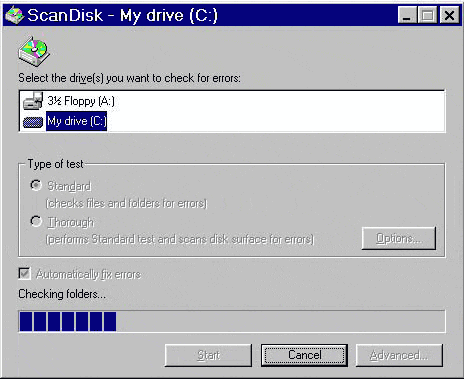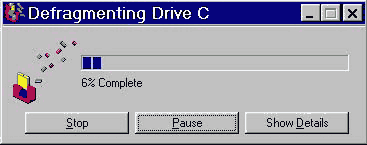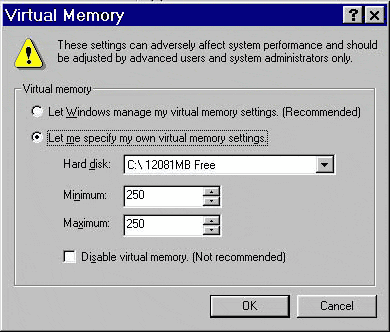
Speed Tricks 1
So, you just got your brand-new Pentium 4, 2 GHz and it's just not fast enough?! I don't think so........however, after a couple of months, you may start to notice that it's getting rather slow - much slower than when you first yannked it out the box.
This is a rather common thing for all computers. The computer runs just fine for a couple of months, and then it starts to get slower and slower. The good news however, is that there's something you can do about it!
This program scans your hard drive for errors. Go to start>run and type "scandisk", or go to start>programs>accessories>system tools>ScanDisk. If you'd like to be notified for every error, and given the option of repairing or ignoring, uncheck the "Automatically fix errors" box. If however you'd like to run the program and leave it, check that box. I strongly recommend fixing all errors unless you have a reason not to (why would you??).
Then you have a choice between Standard and Thorough. Standard just checks the files and folders of the computer for errors, and takes 1-5 minutes to complete. Thorough checks the physical components of the hard drive as well, and can take 1-5 hours to complete! I have never yet found an error in Thorough after having done a Standard test, but it's possibly worth doing especially if your computer is older than a year and/or is moved around a lot.
Before you run the scandisk you should close all programs and turn off the screensaver. This is because every time a program writes to the hard drive, the scandisk starts over again. You can save a lot of time like this. If you have the Task Scheduler icon in your system tray (the area of your toolbar next to the time) then you should right-click it and select "Pause Task Scheduler".
I run scandisk every time my computer crashes or I get "illegal operation" or blue screen of death messages. If I have no such messages, then I scandisk once a week.

When you write information to the hard drive, it gets written to wherever there is free space on the disk. A single file can land up on 4 different parts of the hard drive, and after creating and deleting files for a number of weeks, the file can end up fragmented all over the hard drive. This is no problem, as Windows can find all the pieces of the file, the problem is that this slows down your computer as it needs to rotate the hard drive many times to collect all the files to open a program and run it.
Thankfully, Windows comes with a defragmenting program, that can be found by going to start>run and typing "defrag". You may also find it under start>programs>accessories>system tools>Disk Defragmenter.
All you have to do is select the drive for the program to defrag - in this case, your hard drive. If you have never defragged your hard drive before, and you've had your computer for many months, this may take a number of hours. If however, you defrag your hard drive every week (like I do) then it should take only a couple of minutes.
As with the scandisk, close all programs, switch off the screensaver and pause the task scheduler before running Disk Defragmenter.
I defragment my hard drive about once a week. The more often you do it, the quicker it runs. It is a good idea to defrag if you have installed or deleted a program that's more than 50MB in size.
I have also noticed that I get less illegal operations and fatal exceptions if I defragment regularly.

This is a great trick, and it is needed by almost everybody. Look to the bottom right of your screen, next to the clock (an area called the systray). Count how many icons are there. There should only be one or two, but there can easily be as many as 10 or more!
The reason these icons are there, is that many programs install them so that you can launch them quicker. As there is no option as to whether you actually want them there or not, they start to accumulate. This slows down the startup of your computer, as every single one of the programs is loaded into memory. It also kills your RAM and resources if you don't close them after starting up.
Luckily, there's a very unknown yet extremely useful program that comes with Windows. Click start>run and type msconfig. Go to the startup tab. There you will see the names of various programs that you may recognize. Next to each name is a block, which is either clear, or checked (with a tick in it).
There are a number of programs that are essential to Windows, and must not be turned off. For different computers they can be slightly different, but they are:
1. System Tray (systray)
2. Scan Registry (scanregw)
You will also want to keep any programs that you want to activate on startup in there. These include your anti-virus program, most importantly (if yours scans in the background all the time).
If you see programs that you do not recognize, uncheck them and reboot. If something does not seem right, you can just go back in and change it back again. You can also e-mail me and I will give you my opinion.
If you see programs like "Bob's Colourful Crayon World" and "Jane's easy-to-bake Cakes" in the list, you can be assured that it's ok to remove them from the startup list.
I am very proud to say that when I start up my computer, the only icon in the systray is the speaker icon!
You can view the settings for your virtual memory by right-clicking on your My Computer icon on your desktop and selecting properties. You then go to the Performance tab and you click on the Virtual Memory button.
The default Windows setting for virtual memory is "Let Windows manage my virtual memory settings". Windows says that this setting is recommended, but quite honestly Windows does a rather bad job of it.
Select "Let me specify my own virtual memory settings" and enter the values as follows:
Minimum: Amount of RAM on your computer X 2
Maximum: Amount of RAM on your computer X 2
The reason why this speeds up your computer is quite simple. When you let Windows manage the settings for you, if you have 128MB of RAM and a 20GB hard drive, like I do, Windows assigns you over a gigabyte of virtual memory! This is a ridiculously high amount.
Secondly, because Windows is constantly calculating how much virtual memory to assign you, your hard drive is constantly growing and shrinking in size. This slows down your computer drastically and wastes unnecessary resources. Because the minimum and maximum values are now set the same, Windows knows exactly how much hard drive to assign to virtual memory and it does not need to calculate or move anything.
Do not be daunted by the warning that states that "These settings can adversely affect system performance" blah blah blah... Letting Windows manage the virtual memory adversely affects the system performance, so I don't think anything can be much worse!
You will need to reboot your computer after making changes to the virtual memory settings.
Remember: Setting virtual memory settings to anything less than about 100MB may cause your computer to freeze or crash. If you have 32MB of RAM, you should set the Minimum and Maximum both to about 200MB or more. If you have 512MB of RAM, you only need about 100MB of virtual memory. If in doubt, just follow my guidelines, or experiment until you get the results you require. The more RAM you have, the less memory you need, and vice versa!
